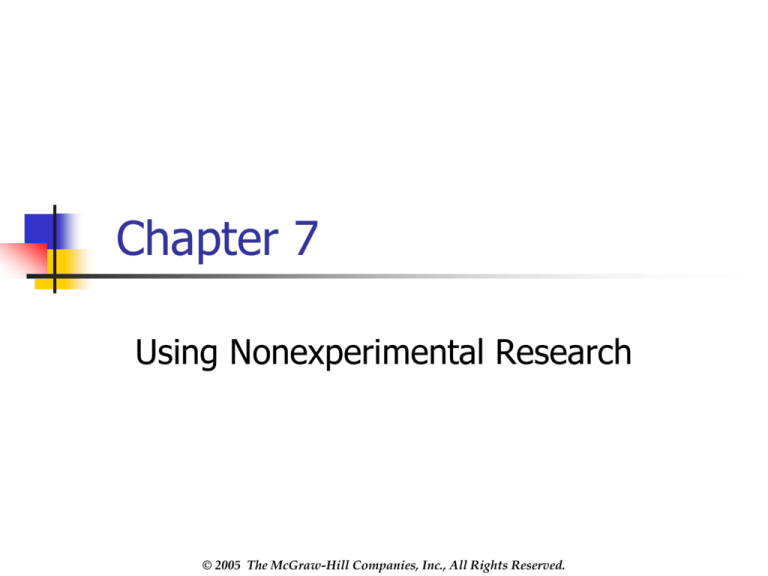
Chapter 7
Using Nonexperimental Research
© 2005 The McGraw-Hill Companies, Inc., All Rights Reserved.
Developing Behavioral Categories
A behavioral category includes the general and specific
classes of behavior to be observed
Categories must be operationally defined
Developing behavioral categories may be easy or
challenging
Behavioral categories must be clearly defined to avoid
confusion
Begin with clear goals for research
Clearly define all hypotheses
Keep categories as simple as possible
Avoid temptation to accomplish too much in one study
© 2005 The McGraw-Hill Companies, Inc., All Rights Reserved.
Quantifying Behavior in
Observational Research
Frequency Method
Duration Method
Record the frequency with which a behavior occurs
within a time period
Record how long a behavior lasts
Intervals Method
Divide the observation period into several discrete
time intervals (e.g., ten 2-minute intervals), and
record whether a behavior occurs within each interval
© 2005 The McGraw-Hill Companies, Inc., All Rights Reserved.
Coping With Complexity in
Observational Research
Time Sampling
Scan subjects for a specific period (e.g., 30 seconds),
and then record your observations during the next
period
Individual Sampling
Select a subject and observe behavior for a given
period (e.g., 30 seconds), and then shift to another
subject and repeat observations
© 2005 The McGraw-Hill Companies, Inc., All Rights Reserved.
Event Sampling
Select one behavior for observation and record all
instances of that behavior
It is best if one behavior can be specified as more
important than others
Recording
Use a recording device to make a record of
behavior for later review
© 2005 The McGraw-Hill Companies, Inc., All Rights Reserved.
Evaluating Interrater Reliability
You must establish reliability of observations from
multiple observers (interrater reliability)
Methods for evaluating interrater reliability
Percent agreement
Simplest method
Percent agreement should be around 70%
Percent agreement may underestimate agreement
Cohen’s Kappa
Popular method
Allows you to determine if agreement observed is due to
chance
© 2005 The McGraw-Hill Companies, Inc., All Rights Reserved.
Pearson Product-Moment Correlation
Correlate ratings of multiple observers with Pearson r
Simple and easy method to evaluate interrater reliability
Two sets of scores may correlate highly, but may still differ
markedly
Intraclass Correlation (ICC)
Extension of Analysis of Variance logic to interrater reliability
A powerful and flexible tool for evaluating interrater reliability
© 2005 The McGraw-Hill Companies, Inc., All Rights Reserved.
Interrater Reliability:
Using Cohen’s Kappa
Tabulate frequencies of interrater agreement and
disagreement in a CONFUSION MATRIX
Determine the proportion of actual agreement by
summing the values along the diagonal of the confusion
matrix and dividing by the total number of observations
Find the proportion of expected agreement by multiplying
corresponding row and column totals and dividing by the
number of observations squared
Enter resulting numbers in the formula for Cohen’s Kappa
A Cohen’s Kappa of .70 or more indicates acceptable
interrater reliability
© 2005 The McGraw-Hill Companies, Inc., All Rights Reserved.
Nonexperimental Approaches to
Data Collection
Naturalistic Observation
Ethnography
Unobtrusive observations of subjects’ naturally
occurring behavior are made
The researcher becomes immersed in the behavioral or
social system being studied. May be conducted as a
participant or non-participant observation study
Sociometry
You identify and measure interpersonal relationships
within a group
© 2005 The McGraw-Hill Companies, Inc., All Rights Reserved.
Case History
Archival Research
You observe and report on a single case
You use existing records (e.g., police records) as your
source of data
Content Analysis
You analyze spoken or written records for the
occurrence of specific categories of events (e.g., a
word or phrase)
Both RECORDING and CONTEXT UNITS are evaluated
© 2005 The McGraw-Hill Companies, Inc., All Rights Reserved.
Issues to Be Considered
in Ethnography
Observing as a participant or non-participant
Gaining access to a field setting
Gaining entry into the group
Becoming invisible
Making observations and recording data
Analyzing ethnographic data
© 2005 The McGraw-Hill Companies, Inc., All Rights Reserved.
Content Analysis: Defining
Characteristics
Used to analyze a written or spoken record for
occurrence of specific behaviors or events
Archival sources often used as sources for data
Appears simple, but may be complex
Should be used within a clearly developed study,
including hypotheses to be tested
Response categories must be clearly defined
A method for quantifying behavior must be
defined
© 2005 The McGraw-Hill Companies, Inc., All Rights Reserved.
Performing a Content Analysis
Clearly defined response categories are essential
Two units of analysis
Recording unit: Element of the material you are going to record
(e.g., instances of a certain word)
Context unit: Context within which material analyzed appears
Observers doing content analysis must be blind so that
bias will not enter the analysis
Materials to be analyzed should be chosen carefully to
increase generality
Cannot be used to establish causal connections among
variables
© 2005 The McGraw-Hill Companies, Inc., All Rights Reserved.
Factors to Include When
Meta-Analyzing Literature
Full reference citation
Names and addresses of authors
Sex of experimenter
Sex of subjects used in each experiment
Characteristics of subject sample (e.g., how
obtained, number)
Task required of subjects and other details about the
dependent variable
© 2005 The McGraw-Hill Companies, Inc., All Rights Reserved.
Design of the study (including any unusual
features)
Control groups and procedures included to reduce
confoundings
Results from statistical tests that bear directly on
the issue being considered in the meta-analysis
(effect sizes, values of inferential statistics, p
values)
© 2005 The McGraw-Hill Companies, Inc., All Rights Reserved.






